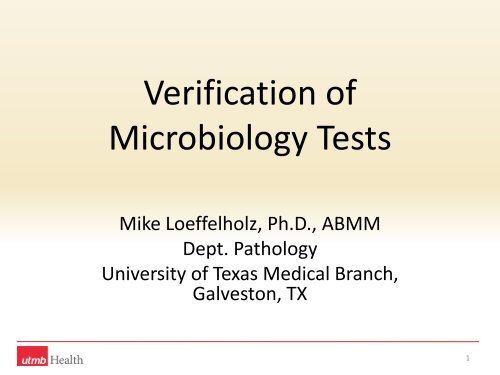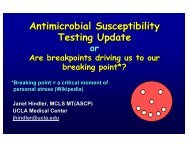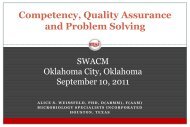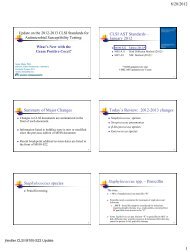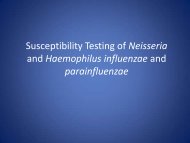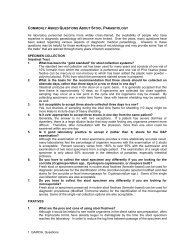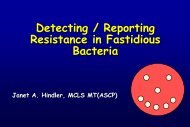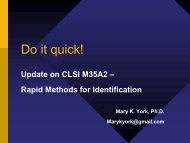Verification of Microbiology Tests - SWACM
Verification of Microbiology Tests - SWACM
Verification of Microbiology Tests - SWACM
Create successful ePaper yourself
Turn your PDF publications into a flip-book with our unique Google optimized e-Paper software.
<strong>Verification</strong> <strong>of</strong><br />
<strong>Microbiology</strong> <strong>Tests</strong><br />
Mike Loeffelholz, Ph.D., ABMM<br />
Dept. Pathology<br />
University <strong>of</strong> Texas Medical Branch,<br />
Galveston, TX<br />
1
Definitions*<br />
• “<strong>Verification</strong> is the one-time process performed to<br />
determine or to confirm a test’s expected performance<br />
prior to implementation in the clinical laboratory;<br />
simply put “Does the test work””<br />
• “Validation is an ongoing process <strong>of</strong> monitoring a<br />
test…to ensure that it continuously performs as<br />
expected; simply put “Does the test still work”...<br />
validation may include personnel competency<br />
assessment, quality control,…pr<strong>of</strong>iciency testing….an<br />
integral part <strong>of</strong> the laboratory’s quality assurance<br />
program.””<br />
* Definitions used by CLIA, CLSI<br />
Source: Cumitech 31A. 2009. ASM Press<br />
2
Definitions<br />
• Modified test: FDA-cleared or approved test<br />
performed outside <strong>of</strong> package insert<br />
instructions<br />
• Laboratory-developed test: procedures<br />
developed in-house that have not been<br />
cleared by FDA. May incorporate commercial<br />
reagents not cleared by the FDA for in vitro<br />
diagnostic use (e.g., RUO or ASRs) or reagents<br />
produced in-house<br />
3
<strong>Verification</strong><br />
• Confirm that test performs as per<br />
manufacturer’s specifications<br />
– What Any FDA cleared/approved diagnostic,<br />
identification, or antibiotic susc test<br />
– When A new test procedure, or different<br />
manufacturer<br />
– How Several analyses using at least 20<br />
specimens. With a well designed panel, these<br />
analyses can be completed in a couple days<br />
4
<strong>Verification</strong> Components<br />
• Accuracy (CAP requires sensitivity and<br />
specificity)<br />
• Reproducibility<br />
• Reportable range<br />
• Reference (normal) range<br />
• Other test characteristics, as applicable<br />
(precision, analytical measurement range)<br />
5
<strong>Verification</strong> <strong>of</strong> Unmodified FDA-<br />
• Accuracy<br />
Cleared Test<br />
– At least 20 specimens (mix <strong>of</strong> positive and<br />
negative)<br />
– Depends on reference method; ≥90%<br />
• Reproducibility<br />
– At least several members <strong>of</strong> 20-spec panel<br />
– Run in duplicate; rpt 2 nd run and 2 nd operator<br />
– Same or comparable results<br />
6
<strong>Verification</strong> <strong>of</strong> Unmodified FDA-<br />
Cleared Test<br />
• Reportable range<br />
– Include positives (from 20-spec panel) with low and high<br />
values<br />
– Test should detect both weak and strong positives<br />
• Reference (normal) range<br />
– May use negative specimens (from 20-spec panel)<br />
– Values should be negative, or produce values below a<br />
cut<strong>of</strong>f<br />
– May use manufacturer’s reference range (pkg insert) if<br />
same patient population<br />
– May use published reference range<br />
Sources: Cumitech 31A; http://www.cms.hhs.gov/clia/downloads/6064bk.pdf.<br />
7
<strong>Verification</strong> <strong>of</strong> Unmodified FDA-<br />
Cleared Test<br />
• <strong>Verification</strong> specimen panel<br />
– Own patient specimens<br />
• Current test serves as reference method<br />
• Split and send to outside lab<br />
– Patient specimens from another lab (or vendor)<br />
– Old pr<strong>of</strong>iciency samples, QC or calibrators<br />
• Should be in appropriate matrix, and have analyte in<br />
clinically relevant concentrations<br />
– Spiked samples (own lab, or provided by vendor)<br />
• Appropriate matrix, and analyte in clinically relevant<br />
concentrations<br />
10
<strong>Verification</strong> <strong>of</strong> Unmodified FDA-<br />
Cleared Test<br />
• Operators who would perform routine patient<br />
testing should perform verification study<br />
• Vendors <strong>of</strong>ten <strong>of</strong>fer to perform/assist<br />
– OK only for fully automated test systems where<br />
inter-operator variability not an issue<br />
– Preferred assistance: free reagents/kits and data<br />
analysis (for complex systems that produce a lot <strong>of</strong><br />
data, such as AST or serology platform), discrepant<br />
analysis<br />
11
Test <strong>Verification</strong><br />
• Accuracy, reproducibility, reportable and<br />
reference range best describe a diagnostic test<br />
• What about an identification test, or AST<br />
– Organism identification test<br />
– AST<br />
• Accuracy (species, genus) and reproducibility<br />
• Accuracy, reproducibility<br />
• Reportable range = both sensitive and resistant strains<br />
12
<strong>Verification</strong> <strong>of</strong> AST<br />
• At least 30 isolates per panel<br />
• Acceptance criteria<br />
– If reference method is not used, no very major<br />
errors<br />
– Less than 5% major errors (one test S or R, other<br />
test opposite result)<br />
– Overall essential agreement (+/- 1 tw<strong>of</strong>old<br />
dilution) and categorical agreement (SIR) ≥90%<br />
Source: Cumitech 31A<br />
13
Test <strong>Verification</strong><br />
• What about blood culture system<br />
– Sensitivity, specificity, reportable & reference<br />
ranges are not applicable<br />
– Seeded bottles<br />
• At least 20 representative isolates spiked at low CFU<br />
• Detection <strong>of</strong> all isolates within expected time<br />
– Parallel study<br />
• Collection <strong>of</strong> both bottle sets; compare both systems<br />
14
Modified <strong>Tests</strong> and Laboratory-<br />
Developed <strong>Tests</strong> (LDTs)<br />
15
Modification Examples<br />
• Change in specimen handling, incubation<br />
time, temperature<br />
• Change in specimen or reagent dilution<br />
• Using a different calibration material (or<br />
changing the manufacturer's set-points)<br />
• Change or elimination <strong>of</strong> a procedural step<br />
Source: CLIA Subpart K, 493:1253<br />
16
Modification Examples<br />
• Change in the cut<strong>of</strong>f or method <strong>of</strong> calculating the<br />
cut<strong>of</strong>f for semi-quantitative assays<br />
• Any change in intended use<br />
– Different sample matrix (e.g. plasma vs. urine)<br />
– Using test for another purpose (e.g. screening vs.<br />
diagnostic)<br />
– Changing the type <strong>of</strong> analysis (e.g. qualitative results<br />
reported as quantitative)<br />
– Etc.<br />
Source: CLIA Subpart K, 493:1253<br />
17
<strong>Verification</strong> vs. Establishment <strong>of</strong><br />
Performance Characteristics<br />
• Under CLIA, labs must establish performance<br />
characteristics <strong>of</strong> modified tests or LDTs<br />
– Requires more analyses and more rigorous studies<br />
• CLIA: verification studies, plus analytical sensitivity,<br />
analytical specificity/interfering substances, others as<br />
applicable (e.g. for quantitative methods)<br />
Source: CLIA Subpart K, 493:1253<br />
18
<strong>Verification</strong> vs. Establishment <strong>of</strong><br />
• CAP<br />
Performance Characteristics<br />
– Perform validation study if test samples or use<br />
collection devices other than those listed in pkg<br />
insert<br />
– Validate modified cut-<strong>of</strong>f value for positive result<br />
– Modified assay has at least equivalent<br />
performance<br />
– Validation studies include “reasonable”<br />
distribution <strong>of</strong> samples for each spec type<br />
Source: CAP <strong>Microbiology</strong> Checklist<br />
19
Modified <strong>Tests</strong> and LDTs—Number<br />
<strong>of</strong> Specimens to Test<br />
• Cumitech 31A: recommended number <strong>of</strong><br />
specimens<br />
– ≥ 50 positive specimens<br />
– ≥ 100 negative specimens<br />
– Rationale: scientifically justified, and laboratories<br />
performing LDTs or modified tests have resources to<br />
perform larger studies<br />
– Number <strong>of</strong> samples may depend on extent <strong>of</strong><br />
modification<br />
– This is a recommendation. Neither CLIA nor CAP<br />
specify number <strong>of</strong> specimens<br />
Source: Cumitech 31A<br />
20
<strong>Verification</strong> Report<br />
• Summarize performance—did it meet your<br />
acceptance criteria (as defined in a verification<br />
protocol)<br />
• Attach raw data<br />
• Director (or designee) must sign the report,<br />
documenting that the test does indeed<br />
perform as per manufacturer’s specifications<br />
• Keep report for life <strong>of</strong> assay, plus 2 years<br />
21
Recent CAP Checklist Changes<br />
• All Common checklist<br />
– Section on test method validation (verification)<br />
• <strong>Microbiology</strong> checklist (Molecular <strong>Microbiology</strong>)<br />
– MIC.63262. Daily QC<br />
• “Daily controls may be limited to electronic/ procedural /<br />
built-in…” if meeting several criteria, including 20<br />
consecutive days <strong>of</strong> validation against external controls<br />
– MIC.63575. New reagent lot validation<br />
• Includes at least 1 positive and 1 negative patient specimen<br />
(by prior reagent lot), and 1 weakly positive pt specimen if<br />
results are reported as such<br />
22
Acknowledgments<br />
• Cumitech 31A coauthors<br />
– Richard Clark<br />
– Michael Lewinski<br />
– Robert Tibbetts<br />
• Cumitech 31A coordinating editor<br />
– Susan Sharp<br />
23


